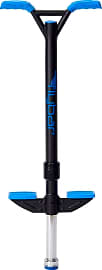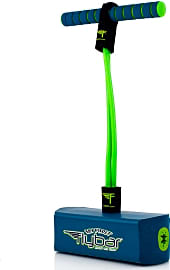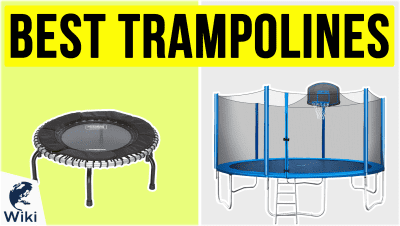The 10 Best Pogo Sticks

This wiki has been updated 42 times since it was first published in October of 2015. Classic toys stand the test of time because they are fun, which is exactly why you'll love getting your jump on with this selection of pogo sticks. It includes something for everyone, from children to adult extreme sports enthusiasts. Your young (or not so young) family members will think they are just having a good time, but they will also be getting in some pretty strenuous exercise, too. When users buy our independently chosen editorial choices, we may earn commissions to help fund the Wiki.
Editor's Notes
November 26, 2020:
The items on this list still provide a comprehensive overview of the various models on offer, from options designed for young children such as the Geopspace Jumparoo Boing! Jr., to robust versions that are made to aid and withstand big jumps and tricks like the Vurtego V4 Pro, or the Super Pogo 1505. Whether your child is only just beginning to negotiate how to hop, or is a skilled performer of tricks and stunts, we always recommend that full protection is worn in the form of helmets and knee and elbow pads.
We removed the Flybar Propel as it doubled-up on a lot of the same features offered by the Flybar Foam Maverick, a model that's also designed for children aged 5 years and over, weighing between 40 and 80 pounds. In its place, we added the Flybar Foam Master, a popular model for kids over 9 years old that require a little more air from their hops. It also has some good safety features to offer a bit of reassurance to the parents of stunt enthusiasts.
We also swapped the Kidoozie G02404 for the Flybar My First Foam, for although they essentially perform the same function and come in at the similar price points, Flybar have produced a more robust version that's proving far more popular.
December 04, 2019:
Pogo sticks can be a fun way to improve balance, coordination, and burn some extra calories. However, they also have a high potential to cause injury, so it is important that neither you nor your children ever use one without a helmet at the bare minimum, and ideally elbow and knee pads, too.
During this update we eliminated the Flybar 1000 Extreme since it seems to have been discontinued by the manufacturer and we expect people to experience availability issues when trying to purchase it from third-party vendors. We replaced it with another extreme stunt model, the Vurtego V4 Pro, which has actually been used to set nine world records and is capable of an impressive 10-foot bounce. Because you can adjust the amount of pressure in its air spring, you can start off slow and increase your rebound as your skills improve.
Other than that, we still stand by most of last year's recommendations and there were few other changes made to our lineup, except to replace the New Bounce Easy Grip and Fisher-Price Grow-to-Pro. Flybar still dominates the list, which is not surprising considering they have been making pogo sticks since 1915. If you aren't interested in the Vurtego V4 Pro due to its exorbitant price, then the Super Pogo 1505 is your next best option for stunts.
For on-the-go fun, the Razor Gogo is great, since its handlebars and foot pegs both fold up. This makes it easy to slip around some luggage in your car or pack away in a closet when not in use. Since kids enjoy jumping just as much as adults, if not more so, we have included the Kidoozie G02404 for your youngest family members and the Flybar Foam Maverick for the slightly older ones who still need a fully foam-covered model for safety.
What Do I Need to Consider Before Purchasing a Pogo Stick?
Perhaps the most important aspect of any pogo stick is its bounce.
Perhaps the most important aspect of any pogo stick is its bounce. Certain pogos have been built with a high-intensity spring (or a compressed-air actuator) for maximizing every thrust, whereas more basic models have been built with a regulated coil for accommodating children, thereby minimizing any risk that they can get hurt.
Generally speaking, a heavier pogo (i.e., 12-15 lbs) will be more buoyant, if not easier to operate, than a lightweight model. The increased buoyancy is a result of a more concentrated coil. The ease of operation is the result of a more focused locus of control. The combination of these two elements render a pogo stick more responsive to pounding, while also decreasing the chances that a user might teeter or fall.
Weight capacity is an important feature when it comes to pogo sticks. On the high end, any person who is too heavy might break the spring on a specific model or cause the rubber cap around the base to "bottom out." On the low end, any person who is too light may not be able to force a pogo stick to bounce. This has particular relevance when it comes to children's pogos, in that certain models feature wider bases and looser springs, thereby making it easier for lightweight kids to hop about.
This brings us to one other feature, which is a pogo stick's height. Ideally, you'll want a pogo stick that stands a few inches above your waist. The majority of manufacturers are sympathetic to this, which is why they sell adult pogo sticks in various sizes of small, medium, and large.
Several Ways to Make The Most Out of Your Pogo Stick
There are a lot of things that you can do on a pogo stick. You can compete to see who can bounce the highest. You can race one another, or you can bounce your way through a homemade obstacle course. If you're an adrenaline junkie, you can take part in "extreme pogo" - a high-risk form of pole vault that only recently became an international sport.
Kids can use a pogo stick to learn balance, agility, and coordination, all while developing leg strength and endurance.
Kids can use a pogo stick to learn balance, agility, and coordination, all while developing leg strength and endurance. Parents can make a pogo stick more fun by wrapping LED lights around it, thereby enabling their kids to bounce around safely in the dark. Teachers can use a pogo stick to teach their students about the elastic properties of physics. Teachers can also use a pogo stick to demonstrate the action-reaction principle of Newton's Third Law.
If you're a fitness enthusiast, hopping on a pogo stick can burn up to 10 calories a minute, while providing an anaerobic workout for your lower-body and your arms. If you're a focused athlete, working out with a pogo stick can have an even greater impact. Pogo sticks are considered "plyometric," meaning that they are exceptional at building the leg muscles most commonly associated with jumping (volleyball and basketball), absorbing shock (skiing, snowboarding, and mountain biking), and developing a strong core (gymnastics, wrestling, and football).
A Brief History of The Pogo Stick
The earliest version of a pogo stick was invented by a Wichita man named George Herrington in 1891. Herrington called his invention the Spring Stilt, and in his patent application he described this stilt as "employing an adjustable spring, which can be used at the will of the operator for leaping great distances and heights."
This single grip made it difficult to maintain balance, and it invariably caused pogo sticks to bounce up hard, striking their owners in the mouth.
Herrington's stilt never really took off, but it did provide the impetus for a slightly more innovative "stilt" that was introduced by a pair of German inventors during the 1920s. These inventors, Max Pohling and Ernst Gottschall, used the first two letters of their last names (i.e., Po- and Go-)to provide their landmark stilt with its name.
This "pogo stick," as it came to be known, featured a single vertical hand grip at the top of its shaft. This single grip made it difficult to maintain balance, and it invariably caused pogo sticks to bounce up hard, striking their owners in the mouth. This problem was eventually corrected by an Illinois toy designer named George Hansburg during 1957. Hansburg introduced the first dual-handle pogo stick. Dual handles have remained the industry standard ever since.
Pogo sticks remained extremely popular throughout the United States until the 1980s, after which they began to lose market share to skateboards, trampolines, and several other forms of recreation. Pogo sticks made a very unlikely comeback, however, when a trio of inventors began experimenting with the idea of using pressurized actuators (as opposed to a traditional spring) inside a pogo stick around the early 2000s. "Extreme pogo sticks" have since provided a significant number of enthusiasts with the ability to engage in back flips, somersaults, and various other unwarranted stunts, all while using a high-powered pogo to launch 6-10 ft off the ground.















